 UPDATED REVIEW & COMPARISON | – June 1, 2024 | Digital Pianos $3000 to $7500 price range | Yamaha, Kawai, Casio, Korg, Roland, Dexibell, Orla – top brands. There are so many choices and so much to consider in shopping for a new digital piano these days, especially in the higher price range. I have written this comparison review to help you in that process. I have included only the best piano brands in this review available in the higher price range of $3000-$7500.
UPDATED REVIEW & COMPARISON | – June 1, 2024 | Digital Pianos $3000 to $7500 price range | Yamaha, Kawai, Casio, Korg, Roland, Dexibell, Orla – top brands. There are so many choices and so much to consider in shopping for a new digital piano these days, especially in the higher price range. I have written this comparison review to help you in that process. I have included only the best piano brands in this review available in the higher price range of $3000-$7500.For price ranges under $3000 I have other reviews which cover those models, but here we are focusing on pianos that are more refined with more advanced piano key actions, have more powerful internal speaker systems, and models that come in a more premium furniture cabinet and that have technology most of the digital pianos under $3000 do not have. *Find out more here and click on pics to see larger views of the pianos.
| Yamaha CLP-785 |
Comparison Report & Review of new digital pianos including Yamaha CLP-745, CLP-765GP, CLP-775, CLP-785, CLP-795GP, NU1XA – Roland LX705, LX706, LX708, GP6 – Kawai CN301, CA501, CA701, CA901, DG30, and Casio AP-550, AP-750, Grand Hybrid GP-310 & GP-510.There are many digital piano shoppers out there who want to invest in a “Premium” digital piano for their home, church, studio, or other area. I consider a Premium digital piano to mean something that retails for at least $3000 and going up in price to about $7500 or more. Once you start looking in that price range there are many good options and the field of available products is very large…but it can be confusing too. In this report I will not be talking about or mentioning (what are known as) interactive auto-accompaniment/player pianos such as the Yamaha CVP-701, CVP-805, CVP-809, and CVP-809GP digital pianos.
They are for different purposes and typically not something that you buy primarily to play traditional piano on.If you want to know more about Yamaha Ensemble Digital Pianos, go to the following review I did on our other web site “Digital Piano Expert” of the new Yamaha CVP “arranger” digital pianos along with all of the other Yamaha digital pianos. What I am talking about here in this report are many of the Premium “digital pianos” that people buy to primarily play piano on and then have some other useful, fun, and practical features that make digital pianos great to own, and in many cases a much better alternative to a regular acoustic piano.
 I have played every single model of the top name brand digital pianos in this Premium price range including the newer Yamaha CLP-785 (top left pic) and the Roland LX708 (left pic) and they are all impressive in their own way. Some have nicer looking cabinets, some have more powerful internal speaker systems, some have more authentic key action, more authentic piano sound and tonal range, more realistic pedaling response, better and/or more numerous digital features such as a large library of instrument sounds, drum rhythms, and multitrack recording features, more intuitive user controls, more advanced innovative technology, and so on.
I have played every single model of the top name brand digital pianos in this Premium price range including the newer Yamaha CLP-785 (top left pic) and the Roland LX708 (left pic) and they are all impressive in their own way. Some have nicer looking cabinets, some have more powerful internal speaker systems, some have more authentic key action, more authentic piano sound and tonal range, more realistic pedaling response, better and/or more numerous digital features such as a large library of instrument sounds, drum rhythms, and multitrack recording features, more intuitive user controls, more advanced innovative technology, and so on.The most important primary things a shopper needs to consider when researching new digital pianos is, in the following order, realism in key action movement and response, piano sound authenticity, and pedaling response (especially the damper/sustain pedal) and its interaction with the piano sound and key action. All other features and functions in terms of their importance should come after the primary features are satisfied.
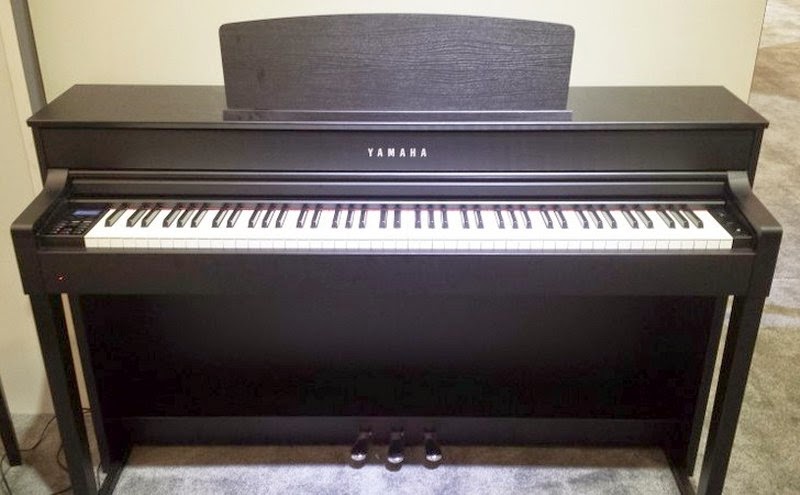 |
| Yamaha CLP-745 matte finish |
When shopping for one of these “premium” digital pianos from Roland, Yamaha, Kawai, and Casio, you will find that in the US, they are only available at local piano stores. In the US these pianos are not available on the internet or general music stores such as Guitar Center, Sam Ash, etc. and you may not be able to find out what an actual discount selling price will be until you actually visit the local authorized piano dealer. In most cases you can find the retail price listed on the manufacturer web site so that will give you a starting place. The retail price will also be different depending on the cabinet finish color and furniture design. So for instance if you want a digital piano from Yamaha, Roland, or Kawai in the polished ebony finish, that will cost you quite a bit more money as opposed to the regular satin finish which usually comes in either black or rosewood and occasionally mahogany or white.
I have found that in many cases in US piano stores, the dealer may not have one or more of the new models in stock or even a demonstrator model to see. This may be because that model is in short supply and not available at that moment or that store just sold what they had, or…that dealer simply does not want to stock that model because they don’t think they can easily sell it. So do not be surprised if you cannot find what you are looking for near you.
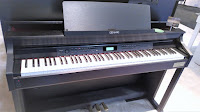 |
| Casio Celviano AP-710 |
So here’s what you need to know about these premium pianos to make a good buying decision. First of all, every piano store will likely say that their brand is better than the competitive brand sold by another company, which is normally what they do, but that does not mean it’s true. All of the top name brands make very good, reliable pianos that will last many years and be good instruments to play on. But that does not mean there are not significant differences among these pianos in a number of ways, some of which you may like and some you may not like. Piano key action, piano sound, dynamic tonal range realism, key touch sensitivity, pedaling sustain, and the speaker system the sound goes through are the vital components and features of any digital piano.
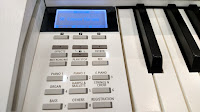 |
| Kawai CN301 control panel |
When shopping in this $3000-$7500 price range you may hear digital piano terms such as graded grand piano hammer action, wood keys, balanced, graded weighted plastic key action, escapement, let-off, counter weighted keys, fulcrum, pivot point, synthetic ivory feel keys, synthetic ebony feel keys, decibel range, audio power, wood piano soundboard, digital piano soundboard recreation, individual note volume and character editing controls, 2-position key cover, minimalistic appearance, General MIDI, wav and MP3 audio recording & play back, piano designer, virtual technician, USB output, USB flashdrive input, multitrack MIDI recording, music library, wireless connectivity with iPad, 3D sound imaging through headphones, touch sensitivity curve, special effects, layering, splitting, LCD display screen, 2-position key cover, decay time, continuous detection pedaling, half-pedaling, redesigned, sympathetic vibrations, pedal resonance, organic, sampled, stereo, Steinway, Bosendorfer, Yamaha, Kawai, and many more.
There are SO MANY terms and features used in some of these pianos that it can quickly become overwhelming and in many cases it usually does. But don’t let these terms scare you. Just concentrate on the basics first and then everything else should fall into place…and if it doesn’t, then you can always contact me and I will try to help you figure it out.
Here are some specifics you should know about these pianos below that may help you:
Yamaha – Yamaha has their CLP-700 series Clavinova models including the CLP-735, CLP-745, CLP-775, CLP-785, CLP-765GP, and CLP-795GP in this price range. There are some great features on these new models and I have reviewed all of them including the CLP-735, CLP-745, and CLP-765GP mini grand at the following link:Yamaha CLP-735, CLP-745, CLP-765GP Review. The CLP-735, 745 and 765GP utilize a similar key actions as in previous models but with the “S”-factor (meaning “redesigned balance pin position and fulcrum” added) and in the CLP-735 and CLP-765GP those models have all plastic keys and the other models have wood keys. In my opinion the wood keys do allow the key action to play more smoothly, move quicker, and are overall worth the price increase.
 The Yamaha NU1XA “hybrid upright” digital piano is a specialty “hybrid” instrument with a real console-uprightkey action from a real Yamaha acoustic console-upright piano and is housed in a traditional looking small upright case. It’s not that the keys are just made of wood like some of the other digital pianos, but the entire key action includes real acoustic piano moving parts, but it has no strings and instead uses optical sensors to sense the movement and velocity of the specialty hammers. In my opinion this NU1X natural key action is more realistic and enjoyable to play than the new Clavinova models as far as a pure “upright” piano playing experience goes. However, the NU1X key action feels like an acoustic upright piano because it has an actual acoustic upright key action in it, and that is very impressive. But there are some very nice hybrid key actions such as what is in a few of the new Kawai and Casio Hybrid models which feel great as well. This may all sound a bit confusing, and it can be, but all these differences among pianos certainly make for a variety of choices!
The Yamaha NU1XA “hybrid upright” digital piano is a specialty “hybrid” instrument with a real console-uprightkey action from a real Yamaha acoustic console-upright piano and is housed in a traditional looking small upright case. It’s not that the keys are just made of wood like some of the other digital pianos, but the entire key action includes real acoustic piano moving parts, but it has no strings and instead uses optical sensors to sense the movement and velocity of the specialty hammers. In my opinion this NU1X natural key action is more realistic and enjoyable to play than the new Clavinova models as far as a pure “upright” piano playing experience goes. However, the NU1X key action feels like an acoustic upright piano because it has an actual acoustic upright key action in it, and that is very impressive. But there are some very nice hybrid key actions such as what is in a few of the new Kawai and Casio Hybrid models which feel great as well. This may all sound a bit confusing, and it can be, but all these differences among pianos certainly make for a variety of choices!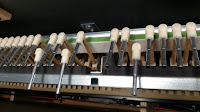 The NU1XA price is $7800 discount internet selling price at Yamaha piano and internet stores throughout the US so it is in a fairly high price range but it is worth the price of admission if you want a digital piano that mimics a real upright piano with just about all of the same key action parts with the exception of strings, hammers, and dampers.
The NU1XA price is $7800 discount internet selling price at Yamaha piano and internet stores throughout the US so it is in a fairly high price range but it is worth the price of admission if you want a digital piano that mimics a real upright piano with just about all of the same key action parts with the exception of strings, hammers, and dampers.Yamaha also has an additional specialty Clavinova piano line called the CSP series which consists of 3 models in this price range called the CSP-255 at $4200, the and CSP-275 at $5700, and the CSP-295 at $7300.These 3 instruments have a special proprietary operating system utilizing a comprehensive software app called Smart Pianist which is a proprietary Yamaha app for iOS tablets. These pianos are like having regular digital pianos and putting them on steroids enabling you to do powerful musical things that you never thought possible on a digital piano.
Unlike steroids, these new pianos are safe for you, good for you, give you access to some very cool new musical and educational features that are not available on most other digital piano with the exception of the Yamaha Clavinova CVP models, and they won’t disappoint you. I will have my reviews of these 3 new models in the near future so stay tuned. Also, Yamaha had previous 1st generation CSP models called CSP170 and CSP150. Those models have now been discontinued and sold out.
Roland –Roland’s recent current models in this price range include the LX705, LX706, LX708, GP3 micro-grand, and GP6 mini grand. However the Roland company just released 3 brand new upright style models for 2024 in this $3000 to $7500 price range called the LX5, LX6, and LX9 with beautiful cabinets, although when it comes to the piano sounds they are somewhat artificial sounding to me. Also, I much prefer the operating system/user interface in the previous models called LX705, LX706, and LX708 as compared to the new ones because they are more intuitive to use. On the new models I feel they are more difficult to figure out and understand in using and accessing the various features and functions in these models.
 Kawai – The CN301 digital piano at $2999 has an all-plastic key actions called RH3 with counterweight technology. The newer DG30 mini grand piano also has the same key action, whereas all the other Kawai digital pianos mentioned here in this review have wood key key actions (the key is wood but not the other parts) which are called “Grand Feel Compact and Grand Feel 3.” All Kawai key actions are hammer weighted, balanced, and graded just like the other brands but that weighting is proprietary for Kawai products. The CN301 has some very impressive upgrades over the previous model including additional new piano samples, new upgraded speaker system, new control panel and new cabinet among other things. It comes in at a popular price point of $2999 discount internet price.
Kawai – The CN301 digital piano at $2999 has an all-plastic key actions called RH3 with counterweight technology. The newer DG30 mini grand piano also has the same key action, whereas all the other Kawai digital pianos mentioned here in this review have wood key key actions (the key is wood but not the other parts) which are called “Grand Feel Compact and Grand Feel 3.” All Kawai key actions are hammer weighted, balanced, and graded just like the other brands but that weighting is proprietary for Kawai products. The CN301 has some very impressive upgrades over the previous model including additional new piano samples, new upgraded speaker system, new control panel and new cabinet among other things. It comes in at a popular price point of $2999 discount internet price.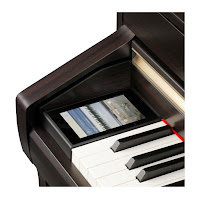 Kawai also produces a model called the ES920 contemporary compact portable piano which has an upgraded piano sound chip over the CN301 (more authentic piano sound in the ES920) but has the same very responsive counter-weight technology key action of the CN301 which is a good thing. The ES920 piano sound chip is also the same one found in the higher end $3800 Kawai CA59 digital piano so it’s a higher end piano sound reproduction. The key movement on Kawai pianos seems more responsive and easier (more lifelike) to play than a few Yamaha key actions in this price range in my opinion.
Kawai also produces a model called the ES920 contemporary compact portable piano which has an upgraded piano sound chip over the CN301 (more authentic piano sound in the ES920) but has the same very responsive counter-weight technology key action of the CN301 which is a good thing. The ES920 piano sound chip is also the same one found in the higher end $3800 Kawai CA59 digital piano so it’s a higher end piano sound reproduction. The key movement on Kawai pianos seems more responsive and easier (more lifelike) to play than a few Yamaha key actions in this price range in my opinion. Both the CA701 and CA901 pianos have a color touchscreen for user navigation and the piano sound-chip has been upgraded (tweaked) for both models. For $4000 to $6400, we believe the CA501, CA701, and CA901 pianos definitely need to be considered because they are extremely competitive in our opinion. Please contact us if you are in the USA so you can find how we can help you get many of these new models for even less money than Amazon or internet price with free shipping and no tax, brand new. Check out our detailed reviews on the newer Kawai CA401 and Kawai CA501 at the following links to learn more about it: Kawai CA401 REVIEW Kawai CA501 REVIEW
Both the CA701 and CA901 pianos have a color touchscreen for user navigation and the piano sound-chip has been upgraded (tweaked) for both models. For $4000 to $6400, we believe the CA501, CA701, and CA901 pianos definitely need to be considered because they are extremely competitive in our opinion. Please contact us if you are in the USA so you can find how we can help you get many of these new models for even less money than Amazon or internet price with free shipping and no tax, brand new. Check out our detailed reviews on the newer Kawai CA401 and Kawai CA501 at the following links to learn more about it: Kawai CA401 REVIEW Kawai CA501 REVIEW KAWAI also has their first ever mini digital grand piano called the DG30 which sells at $6199 discount price plus tax which is a bit mores money than the newer Yamaha CLP-765GP. This newer Kawai digital grand model is patterned after their successful CN301 vertical upright digital piano and has many of the same features including the popular Kawai RH3 “quick movement” key action, their sampled acoustic piano sound chip, General MIDI instrument sounds, 4 speaker sound system, and accurate pedaling among other things.
KAWAI also has their first ever mini digital grand piano called the DG30 which sells at $6199 discount price plus tax which is a bit mores money than the newer Yamaha CLP-765GP. This newer Kawai digital grand model is patterned after their successful CN301 vertical upright digital piano and has many of the same features including the popular Kawai RH3 “quick movement” key action, their sampled acoustic piano sound chip, General MIDI instrument sounds, 4 speaker sound system, and accurate pedaling among other things.This newer small size mini grand is a 34″ deep model, so just a bit less than 3′ deep which makes it smaller than the competing Yamaha CLP-765GP and Roland GP607 and therefore able to fit into smaller places more easily. This new piano is a full featured model and it looks very attractive in its new polished ebony cabinet. With Kawai quality and being a very respected name in the piano industry, their first digital mini grand piano should do well for them. Please go to the following link to read more about it. Kawai DG30 mini digital grand piano
Casio – In the history of Casio digital pianos which is about 35 years, Casio has only produced digital Hybrid pianos for about 6 years. In the $3000 range they have a new 2024 model called the AP-750 which sells on-line for $3399. This model has a “hybrid” spruce wood & resin key action and new stereo Stienway based grand piano sound samples. I really like this new model for it’s cabinet design and appearance along with its more realistic piano playing ability. I have played this model many times and will have my review of it up on this blog site very soon…so as they say… “stay tuned.”
In the $4000 + price range, Casio has 2 impressive upper end models called the “Grand Hybrid” because they are supposed to offer a more grand-piano-like playing experience.Casio has definitely stepped up to the plate and hit a home run with these new models, especially because of its proprietary key action on the Celviano GP-510 & GP-310. These 2 newer models for 2024 have a full size, all-wood extra long grand piano style keys with moving composite hammers built by the famous German grand piano company Bechstein of Germany.
These pianos also have a more powerful speaker system and better, more natural piano tone and sustain. Bechstein is very well know in Europe and around the world but they certainly are not a mainstream brand here in the US. But this association with renowned acoustic piano company Bechstein gives these new Casio digital pianos the credibility and prestige it needs to compete with the “big dogs” in this price range including Kawai, Roland, and Yamaha. Casio is certainly a big dog in digital pianos under $1000 so they have a proven past for many years.
But these Grand Hybrid digital pianos open up the way for Casio to be taken seriously when it comes to advanced digital pianos in terms of piano key action, piano sound, pedaling, and digital features along with elegant furniture cabinets. I would recommend you read my detailed review of these new models before you make any buying decisions in this price range. Casio GP-310 and GP-510 Review.
| Yamaha CLP control panel |
When it comes to piano sound and all that it entails, each manufacturer tells you they have the most realistic, most authentic, most natural sound available in a given price range. What else would you expect from them? They use proprietary terms to make it sound like they have created the ultimate piano sound. However, piano sound is somewhat subjective depending on your ears (sensitivity to certain frequencies or tones), musical listening experience, piano playing experience, and your expectations. You could literally be happy playing any of these brands and models even though a local piano store would tell you otherwise because they want to sell their brand(s). The manufacturers use fancy and impressive words and phrases to describe their piano sound, but at the end of the day those words are meaningless when it comes to the actual sound you are hearing because it is subjective (as I mentioned) and also subject to the way the internal speaker system projects the sound from inside these digital pianos.
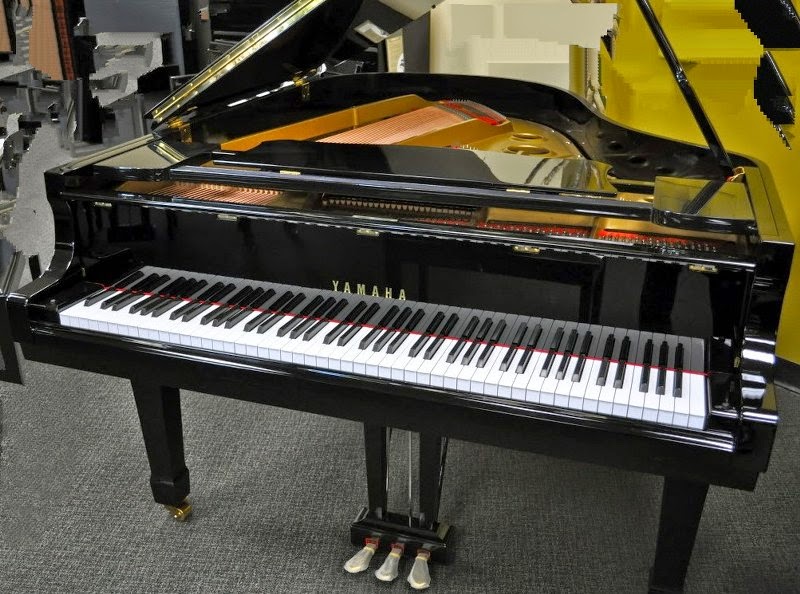 To get the best acoustic piano sound reproduction possible with available technology, Yamaha uses their own Yamaha acoustic pianos to make a sample/recording piano sound. Yamaha also uses a European Bosendorfer acoustic grand piano to sample/record another piano sound for their digital pianos. Yamaha uses Bosendorfer because they own the company…so why not:). I have played many Bosendorfer grand pianos over the years and they are beautiful pianos and compare well to the Yamaha, Kawai, and Steinway acoustic grand pianos in my opinion.
To get the best acoustic piano sound reproduction possible with available technology, Yamaha uses their own Yamaha acoustic pianos to make a sample/recording piano sound. Yamaha also uses a European Bosendorfer acoustic grand piano to sample/record another piano sound for their digital pianos. Yamaha uses Bosendorfer because they own the company…so why not:). I have played many Bosendorfer grand pianos over the years and they are beautiful pianos and compare well to the Yamaha, Kawai, and Steinway acoustic grand pianos in my opinion.
Take it from me, a person can be musically happy and satisfied on a new digital piano without necessarily spending more than you have to, because even in the lower price ranges some of these digital pianos sound and play great!
 |
| Roland control panel |
When it comes to the user interface control LCD screens, almost all of the Yamaha & Kawai models use a larger LCD display screen located to the left side of the keyboard. Roland uses a smaller display screen located in the middle above the keys. Although the Kawai,Yamaha, and Casio pianos display info that is a bit easier to see with their larger screens I personally like the Roland design a bit better because it is in your direct line of sight above the keys in the middle and is easy to see and the buttons are somewhat more intuitive to use in my opinion in navigating the many features but unfortunately the piano sound itself doesn’t live up to our expectations and sounds artificial, especially on their new LX models.
If you want to save money and stay in a lower price range, then buying a digital piano under $3000 will still get you a Premium quality digital piano in the Yamaha, Roland, or Kawai brand in a satin cabinet finish. The polished ebony or polished white Premium digital pianos always add a big increase in price to the name brand pianos in various price ranges, sometimes as much as $500-$1000 depending on the piano model. I believe all of the models here offer attractive cabinets, very good features, are reliable in quality, offer substantial factory warranties, and can satisfy a lot of musical needs, but as I said before, there are definite differences among brands and models. I like to stress that you cannot always “judge a book by its cover” in thinking a digital piano must be good if it has a nice looking cabinet. I have seen some very nice looking cabinets with beautiful finishes that are very poor pianos when it comes to how they play and sound.
People constantly make the mistake of buying a piano on “looks” rather than how it really plays and behaves as a piano. One of the brands that are not near as popular but have some attractive cabinets is the Kurzweil brand. Based on all my personal experience with their current line of pianos, I find that the Kurzweil piano sound/touch response, pedaling, and key action are erratic and uneven and/or are missing fundamental piano playing technology found in the major brands and come nowhere close in quality and authenticity to the pianos I have listed in this report. Also based on my years of personal experience with their digital piano products, the reliability of the electronics and availability of service to repair Kurzweil digital pianos has not been very good over the years.
 |
| Roland |
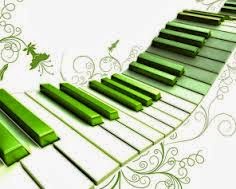
It’s really best to stick with brands that are proven winners in overall piano performance, digital technology, and reliability and those brands are definitely Roland, Kawai, Casio, and Yamaha in the $3000-$7500+ price range. Just so you know, the top digital piano in each brand are the Roland LX708 polished ebony, the new Kawai CA901 polished ebony, the newer Yamaha CLP-785 polished ebony, and the Casio Grand Hybrid GP-510, and they all retail for approx $7300 or more for the polished ebony cabinet models. The more money you spend in each brand, the more you will typically get in terms of features, functions, piano sound realism, and key action authenticity as well as upgraded cabinet design and cabinet finish. However, the most important feature in any piano would be the key action and the way it moves & behaves.
The best Yamaha Clavinova key action in my opinion is in the CLP-785. With the Kawai brand, their best key action comes in their Concert Artist series (CA701, CA901) as well as being available in a wide selection of cabinet color/finish choices and price points among those models.
expensive models ($1000-$2000) can be more than enough for many people who just want to play music recreationally for their own enjoyment.
However, there are some naturally occurring organic acoustic piano elements in every good acoustic upright & grand piano which transcends brands and models and that is what digital piano shoppers should try to concentrate on when shopping for a digital piano instead of so-called piano perfection. It really has to do with musical and playing enjoyment so a digital piano does not have to be “perfect” for you to have that enjoyable piano playing experience.
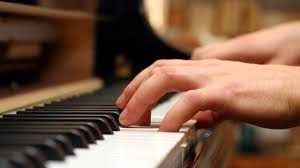
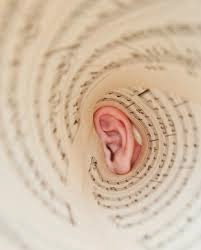 Other variables that should be considered when shopping for one of these digital pianos is that everyone’s hand and finger muscles as well as the way they hear sound frequencies are different and that will have a bearing on what someone will like in terms of key action and piano sound. I have talked with thousands of digital piano shoppers all over the world about this subject including my own students over the years, and although I find that most people would agree with my analysis and opinions of these various digital pianos with regard to key action and piano sound, there are others who may have a different viewpoint, but that does not mean they are wrong. For instance I have found that some people do not like the Roland piano sound as much as they do the Kawai or Yamaha piano sound and yet many people like the new Roland piano sound better and believe it is more expressive than either of the other two brands.
Other variables that should be considered when shopping for one of these digital pianos is that everyone’s hand and finger muscles as well as the way they hear sound frequencies are different and that will have a bearing on what someone will like in terms of key action and piano sound. I have talked with thousands of digital piano shoppers all over the world about this subject including my own students over the years, and although I find that most people would agree with my analysis and opinions of these various digital pianos with regard to key action and piano sound, there are others who may have a different viewpoint, but that does not mean they are wrong. For instance I have found that some people do not like the Roland piano sound as much as they do the Kawai or Yamaha piano sound and yet many people like the new Roland piano sound better and believe it is more expressive than either of the other two brands.
When it comes to any one of these pianos I have talked about, I really don’t think a digital piano shopper can make a wrong decision here, especially in this higher price range. But if you want a digital piano that will fit your musical desires and/or needs, then the differences in these pianos can really mean something. For me, I do have some personal preferences in piano sound and key action, along with pedaling realism, but I tend to keep that info at a minimum on my blog site because this is not about me, it is about you🙂.
I have played all of these new digital pianos many times and have done individual reviews on all of them, except for the Kawai pianos mentioned here. I will be doing that soon and when I do I will link those Kawai reviews from this blog post so you can get even more details from me on each model. You can also go to the manufacturer web sites to get more details, although those sites do try to “sell you” on their product…as they should:).
No matter which brand you purchase, they are all solid, reliable brands which excellent factory warranties and good overall reputations. As with anything, people will lean one way or the other with regard to what they feel is important to them in a new digital piano within their price range. You could likely be happy on any of these new models but obviously there differences and you’ll need to determine what fits you best.
If you want more info on new digital pianos and LOWER PRICES than internet discounts, please email me at tim@azpianowholesale.com or call direct at 602-571-1864 .






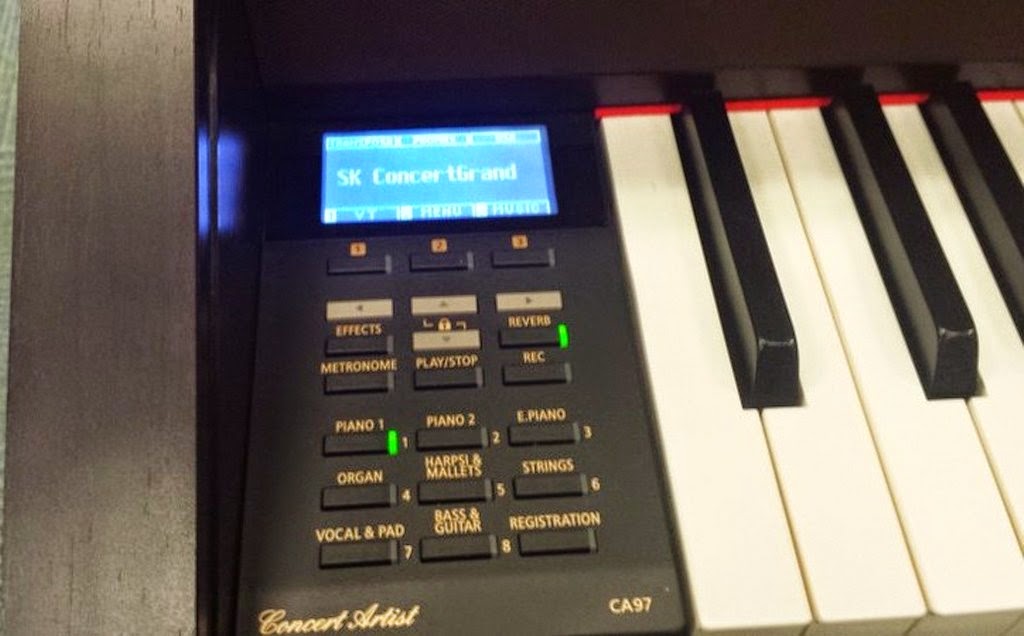
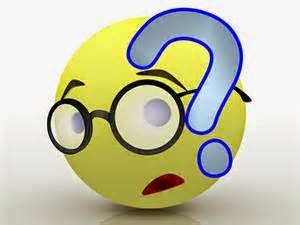










Very very good review. Simply, the best.
Thanks
Exactly the kind of article i was looking for. Thank you very very much for your work and experience !
Thanks for a well covered review on a range of premium digital pianos, which I'm in the market for. I'm curious on when a full review on the CVP-585 will be done, though?
I have 2 choices clp 545 and 90se .i have not decided yet . Which one do you advice me to buy? Thank you
Several years ago I found I needed a silent piano for practice to supplant my wonderful Schimmel grand piano, so I wouldn't bother my family during long practice sessions. I spent quality time on the phone with the author of this blog, and I shopped extensively, eventually choosing the Kawai CA-65.
I'm not a bells and whistles guy; I just wanted the best feel and sound. After playing the best that Yamaha and Roland (and others) had to offer, it was clear that the Kawai was it for me, no comparison. I knew it right away. I went back and played the Yamaha and the Roland again to be sure, then back to the Kawai for a final check, and the purchase.
Now, several years later, this has absolutely been the most important piano of my life. I find playing it so enjoyable that I end up practicing much, much more than I ever have before, and my playing has improved dramatically as a result.
The recording and playback feature is a great learning tool, and even more important, the Kawai has many different piano voices to choose from: Concert Grand, Studio Grand, Mellow Grand, Jazz Grand, Pop Piano, Upright, etc. They each sound very different obviously, but more importantly they PLAY differently, and they require different technique and rhythym to sound right. If I play one for a while and then switch to another, I have to adjust my playing technique to make it sound good. The result is when I meet up with a "strange" piano I've never played before, I can make it sound great much quicker than ever before. I can adapt!
This is my advice to any of you out there looking: play a few of these instruments, then go back and play the one or two you like best again. When one of them is right for you, you will know it. Use headphones so you are not self-conscious of your playing and are just focusing on how it feels and sounds TO YOU.
Happy hunting!
Hi. Tim, nice guide. I am wondering if you had a chance to play new CASIO GP300/500 and where would you put them within those. I am in Washington DC and it seems that nowhere has it. Thanks.
I have played the Casio GP300 but have not published a review on it yet. I am not "sold" on that model so am waiting to play a GP500 to see if I like it better. My preference at the moment is the new Roland HP605. I recently published a review of it.
Hey Tim,
I'm having a big doubt here and would be very important and nice if you answered me. I can't decide between clp 545 and hp 603. In YOUR opinion, which one is better?
Please, answer me!!! Thanks!
They are both good but both different. My personal preference is the new Roland HP603 for more authentic key action movement, piano sound and tonal dynamics, and functionality. The speaker system is a bit more powerful and fuller on the Yamaha but I prefer the Roland for all the other reasons.
Dear Tim,
I am doubting for some time between de Roland HP 605 and the Kawai CS 8. I tried them both a few times, but… What would be your preference?
Dear Tim,
I hesitate between CLP 525 and CN 25 (I'm a beginner and I would like to play for my own pleasure). What would you advise ?
Thank you very much !
I'm interested in the Kawai CA67 or newer CS8. Where can I find one for a good price?
Absolutely super blog. Thank you so much for taking so much time to prepare it. One comment: I was quite attracted to the Yamaha NU1….UNTIL….on Youtube I read about an issue involving irregular spiking of sounds on some notes. And, several 'posters' experienced the same issue. For me, that would be sufficiently annoying to disqualify the NU1. Are you aware of this issue?
unusual intermittent and uncontrollable volume changes when when keys are played is usually the result of bad electronic sensors/contacts. Whether those sensors are optical or physical, if they are not working correctly then when a key is depressed an electronic sensor may not respond accurately and if that happens then it can cause a sudden jump in volume of the key being played or even an intermittent loss of the note being heard. I have seen this happen before in the NU1 on occasion.
I'd love to read a review of the new Kawai CA98 and CA78 if you get to play one or both of them!
This is (by far) the most comprehensive and understandable review of mid to high end digital pianos that I have found. Thank you very much for your comparisons, descriptions and insights!
Hi Tim, I really enjoy your reviews and find excellent advice regarding Yamaha, Casio and Roland, however I'm still waiting on you getting on with the best Kawai models such as Cs11 Cs8 and the CA97 and 67 which have now been superceeded by the CA98/CA78. Have you fallen out of favour with Kawai as your're now way behind the curve with Kawai reviews.
I'm debating between the Roland HP603 and the Yamaha 635/645, though now I"m looking at the Kawai CA series as well. It's equally for me (I've taken about 5-6 years of lessons over the past 20 years, so I'm fairly novice) and my two boys who are just starting out. I honestly don't consider myself knowledgable enough to know which is the most realistic feeling/sounding. I'm also weighing the tech features because if it helps keep my boys interested in playing/practicing, that helps, too. I'd like to stay under $3k, and it seems that looking around locally, I can get each of those in that price range. Thoughts? And of course, I'd entertain looking at your wholesale pricing, too.
Hi Tim
Really great post! Thank you. I've been looking at the Casio GP300 and the Roland HP704, Roland LX705 and then an even a lower priced Casio AP470. Any thoughts on comparisons. I want something I can play permanently without compromising playing technique (did grade 7 level many many years ago, and now returning to piano for the first time in 20 years) to build up my skills again. I liked the lighter feel of the Roland and the additional synth features, but wonder if the Casio's action is better for brushing up technique.
Hi, when do you think you will have the Kawai CN201 review online? I love the look of it being a recent release with decent screen, and presuming or hoping it’s comparable to Clavinova 725/735?
Thanks,
Andy